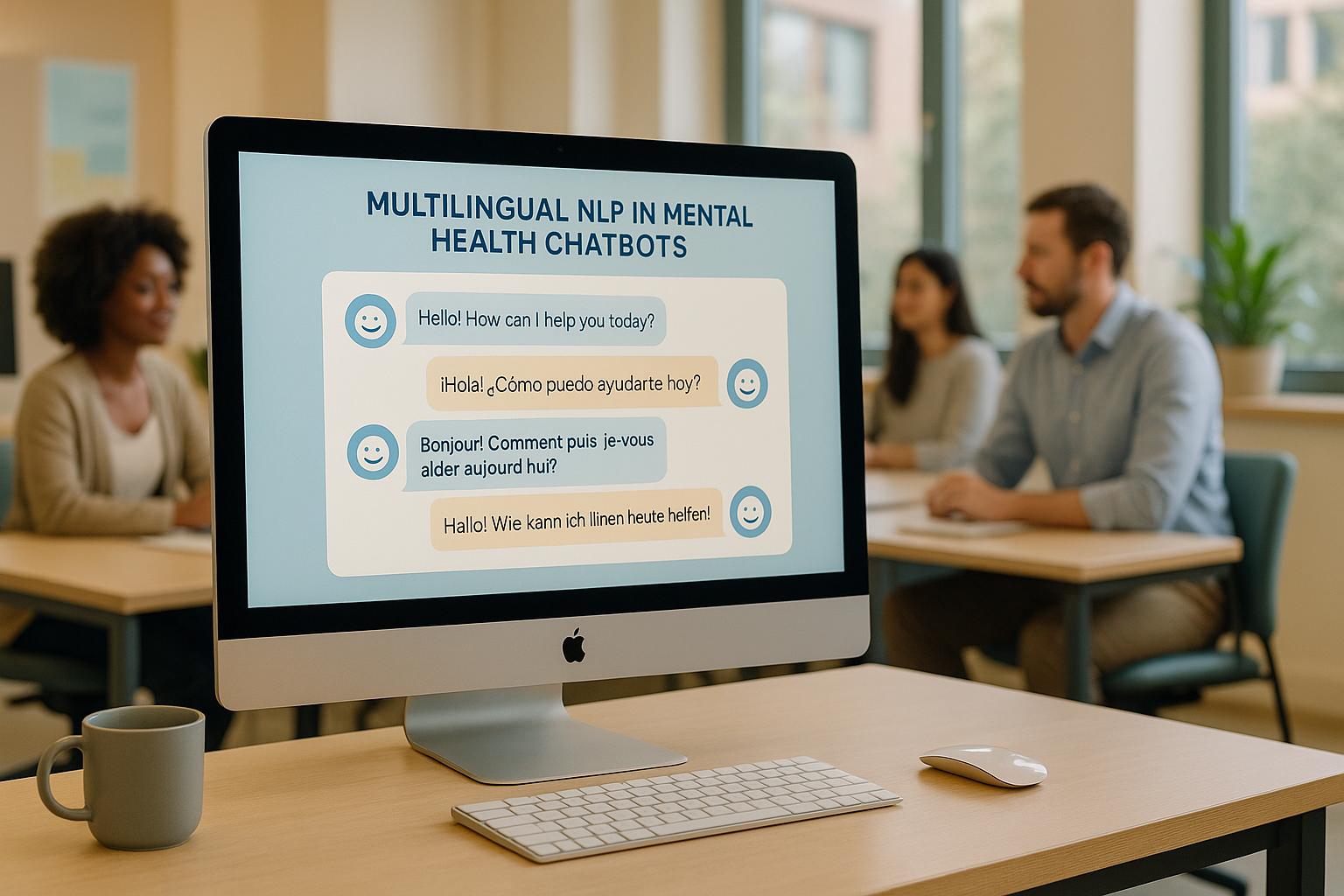Multilingual NLP is transforming mental health support by enabling chatbots to communicate in multiple languages, addressing language barriers that often prevent people from seeking care. These AI-driven tools go beyond simple translation, interpreting emotional nuances and regional expressions to provide personalized mental health assistance.
Key takeaways from the article:
- What It Does: Multilingual NLP allows chatbots to understand and respond in users’ native languages, improving emotional connection and engagement.
- Why It Matters: Language barriers prevent many from accessing mental health care. Multilingual chatbots offer private, 24/7 support, especially in underserved areas.
- Technology Behind It: From rule-based systems to advanced large language models (LLMs), these tools are becoming more sophisticated but require more clinical validation.
- Challenges: Limited data for minority languages, cultural differences in mental health expressions, and ethical concerns remain hurdles.
- Real-World Example: Aidx.ai uses advanced NLP to deliver personalized, multilingual support, combining therapy techniques like CBT and DBT with privacy-focused features.
The future of multilingual NLP in mental health lies in expanding language coverage, rigorous clinical testing, and addressing ethical risks to ensure accessible and effective care for all.
A Multilingual Solution for Health Surveys: The Role of AI in Person-Generated Health Data (PGHD)
Research Findings on Multilingual NLP in Mental Health
Recent studies are shedding light on how multilingual natural language processing (NLP) is reshaping mental health care. While the technology offers promising benefits, it also comes with limitations, emphasizing the need for thoughtful design to improve clinical outcomes.
Key Study Results
Research shows that multilingual NLP enhances engagement, accessibility, and intervention delivery, especially for mental health conditions like anxiety, depression, and burnout [1][2]. By enabling chatbots to communicate in multiple languages, this technology reaches diverse populations, creating a better user experience for those who may not speak English fluently [2][5].
One study revealed that over half of its participants experienced improvements in their mental well-being after using a multilingual platform [7]. The findings underline how language accessibility plays a key role in boosting user engagement and improving therapeutic results.
However, not all outcomes have been positive. Some studies reported an increase in depressive symptoms among users [2]. These mixed results highlight the importance of careful implementation and continuous evaluation when deploying multilingual mental health tools.
Another important takeaway: people are more likely to trust and engage with these tools when they can communicate in their native language. This leads to greater self-disclosure and deeper participation in therapeutic interventions [2][5]. In mental health care, where open communication is essential, this can make a significant difference.
Multilingual Mental Health Chatbot Designs
Current multilingual mental health chatbots fall into three main categories, each with its own strengths and weaknesses.
| Chatbot Architecture | Target Conditions | Clinical Efficacy Testing |
|---|---|---|
| Rule-Based | Depression (58%), Anxiety (62%) | High (57% for depression, 58% for anxiety) |
| Machine Learning-Based | Therapeutic Interventions (27%) | Moderate |
| LLM-Based | General Mental Well-being (28%) | Low (16% of studies) |
Rule-based systems rely on predefined scripts and decision trees. While they require manual translation for each language, they have shown strong clinical testing results. These systems are particularly effective for structured interventions targeting conditions like depression and anxiety [3][1].
Machine learning-based models take multilingual capabilities a step further. By training on multilingual datasets, these systems adapt better to different languages and contexts. Although their clinical validation rates are moderate, they are increasingly used for therapeutic interventions [3][1].
Large Language Models (LLMs), such as ChatGPT, represent the most advanced option. They handle natural, multi-language conversations at scale and can even grasp emotional undertones, cultural nuances, and regional dialects [3][8]. By 2024, 45% of new studies in the field focused on LLM-based chatbots [3]. While these systems show immense promise, their clinical efficacy testing remains limited, with only 16% of studies rigorously evaluating their therapeutic impact [3].
Despite their potential, LLMs and other systems still face challenges in proving their effectiveness through clinical validation.
Gaps in Clinical Testing
For multilingual NLP to truly transform mental health care, addressing the gaps in clinical testing is critical. Research shows that only 47% of chatbot studies focus on clinical efficacy testing, with LLM-based systems being especially underrepresented [3]. This gap between technological potential and proven therapeutic benefits raises concerns.
The lack of standardized evaluation frameworks further complicates matters. Few chatbot interventions undergo rigorous testing [2][3][4], making it difficult to assess their true value and safety. This is particularly challenging for multilingual tools, where linguistic and cultural differences add layers of complexity to the evaluation process.
Experts stress the need for standardized evaluation methods that cover technical validation, pilot studies, and thorough clinical testing [3]. Without these measures, there’s a risk of deploying tools that may be ineffective – or worse, harmful – to vulnerable users.
The ChatPal study highlights both the potential and the challenges in this field. While the study showed general improvements in participants’ well-being, not all results were statistically significant [7]. It also pointed out how technical issues can affect user experience and outcomes, emphasizing the need for refinement.
To move forward, researchers suggest transparent reporting of chatbot designs and benchmarking against medical AI certification standards [3][4]. These steps would help ensure safer and more ethical use of multilingual mental health technologies as they continue to evolve and expand.
How Multilingual NLP Improves Access and Inclusion
Multilingual NLP is not just about breaking down language barriers – it’s about creating opportunities for better access and greater inclusion. By enabling AI-powered chatbots to provide mental health support where traditional systems fall short, this technology is shaping a future where community-specific needs are addressed more effectively.
Supporting Diverse Language Communities
Language barriers remain one of the toughest challenges in global mental health care. AI chatbots powered by natural language processing (NLP) are stepping in to fill this gap, offering mental health support across multiple languages [1]. This approach ensures that underserved populations – especially in areas where there’s a shortage of professionals fluent in local languages – can access the help they need.
But this goes beyond simple translation. Multilingual NLP allows chatbots to interpret and respond to conversations in ways that cater to specific linguistic and cultural contexts [2]. For instance, a Spanish-speaking immigrant in Texas or a Mandarin-speaking student in California can receive personalized support without the long wait times often tied to finding bilingual therapists. Research shows that people are more likely to connect with tools that feel relatable and engaging, especially when those tools communicate in their native language [2].
That said, challenges persist. Studies have revealed that while these systems offer natural, conversational interactions, they don’t always deliver equal benefits to all groups [4]. This highlights the need for ongoing refinement to ensure fairness and inclusivity.
Reducing Stigma Through AI-Based Support
Multilingual NLP doesn’t just enhance access – it also tackles the stigma around mental health. Stigma varies widely across cultures and often prevents people from seeking help. AI chatbots offer a private and judgment-free space, making it easier for individuals – especially those in immigrant communities – to access support without fear of social judgment or discrimination [2].
These chatbots also play a role in improving users’ coping skills. By analyzing past conversations, they can provide tailored advice and timely interventions to help manage mental health challenges [2]. Additionally, they’ve been shown to encourage self-disclosure and identify individuals at higher risk [4]. However, developers need to tread carefully. Ethical concerns, such as reinforcing biases or unintentionally perpetuating stigma, remain a critical consideration [4]. Ensuring that these systems are free from cultural and ethical blind spots is essential.
Meeting Regional Mental Health Needs
Mental health expressions and experiences differ widely across regions and cultures, and multilingual NLP must adapt to these variations. Research highlights the importance of tailoring NLP techniques to regional and cultural nuances [6]. For example, what one culture identifies as anxiety or depression might be expressed completely differently in another.
Conditions like anxiety, depression, suicidal ideation, and insomnia are common worldwide [1], but the language used to describe them can vary significantly. In some Latin American cultures, depression might be described with terms like “nervios,” reflecting a sense of being overwhelmed. In many Asian cultures, mental distress is often expressed through physical symptoms rather than emotional language. For chatbots to be effective, they need to go beyond direct translations and understand these cultural subtleties, including metaphors, idioms, and indirect communication styles. Machine learning and deep learning techniques must be designed with these complexities in mind [1].
The potential here is massive. If chatbots can provide effective mental health support at scale, they could improve the well-being of millions at a relatively low cost [4]. Many people are already using these systems as a form of mental health support [4]. However, challenges like adapting to regional contexts, addressing privacy concerns, and ensuring accuracy remain significant [3]. Failing to address cultural and linguistic nuances could amplify these issues.
The real measure of success for multilingual NLP lies in its ability to bridge not just language gaps but also cultural divides. As this technology evolves, the priority must be to create tools that are inclusive, culturally sensitive, and clinically effective for the diverse communities they aim to serve.
sbb-itb-d5e73b4
Case Study: Aidx.ai‘s Adaptive Therapeutic Intelligence

The use of multilingual NLP in mental health chatbots is transforming how individuals access care, and Aidx.ai stands out as a prime example. By combining multilingual NLP with personalized therapy, Aidx.ai tackles language and cultural barriers head-on. Recognized as AI Startup of the Year by the UK Startup Awards in both 2024 and 2025, the platform takes therapeutic AI to new heights. Its ability to adapt to users’ communication styles and cultural backgrounds makes it a standout in the field.
Multilingual Support in Aidx.ai
Aidx.ai goes beyond simple translation. It offers culturally sensitive, voice-enabled support designed to connect with users in their native languages. Using advanced speech recognition and processing, the platform ensures that interactions feel natural and meaningful. This is especially critical in mental health, where expressing emotions in one’s native language can make all the difference. For someone grappling with anxiety or depression, being able to communicate with cultural and emotional nuance can encourage them to seek help rather than shy away from it.
The platform’s multilingual capabilities set the foundation for its adaptive personalization, which fine-tunes therapeutic interventions to align with users’ cultural and emotional needs.
The Adaptive Therapeutic Intelligence System™
At the core of Aidx.ai is its Adaptive Therapeutic Intelligence (ATI) System™, a self-learning AI designed to deliver highly personalized care. Unlike generic chatbots, the ATI System™ evolves with each interaction, learning about the user’s communication style, emotional patterns, and preferences to provide a tailored therapeutic experience.
This system incorporates various evidence-based therapeutic methods, such as Cognitive Behavioral Therapy (CBT), Dialectical Behavior Therapy (DBT), Acceptance and Commitment Therapy (ACT), and Neuro-Linguistic Programming (NLP). For multilingual users, these techniques are adapted to fit their cultural context. For instance, if a user benefits from structured exercises, CBT techniques are emphasized. On the other hand, if emotional support is the priority, the system may lean toward ACT or DBT.
Aidx is purpose-built for coaching, therapy, and personal growth: a coach that understands you, challenges your blind spots, and follows up when you get distracted. The Aidx Adaptive Therapeutic Intelligence (ATI) at its core is built to track your patterns over time and keep iterating until it gets you actual results.
This dynamic personalization mirrors the way a human therapist deepens their understanding of a client over time. For multilingual users, the system also adjusts to cultural communication styles, offering direct feedback for some and a more nuanced approach for others. This adaptability ensures that the platform not only meets diverse user needs but also respects their preferences, all while maintaining strong privacy protections.
24/7 Access and Privacy Features
Aidx.ai ensures constant availability paired with robust privacy safeguards. For instance, its incognito mode automatically clears session data after 30 minutes of inactivity. Accessible via web and mobile apps, the platform adheres to GDPR compliance and employs end-to-end encryption to address privacy concerns, especially in contexts where stigma around mental health remains high.
The combination of voice interaction, cultural sensitivity, and privacy features creates a space where users can engage openly with mental health support. By removing language barriers, avoiding cultural missteps, and addressing privacy worries, Aidx.ai allows users to fully focus on their therapeutic journey. This marks a major improvement over traditional mental health services, which often struggle to provide care across diverse languages and cultural contexts.
Aidx.ai’s seamless integration of multilingual capabilities, adaptive personalization, and privacy-first design showcases how advanced NLP technology can tackle real-world challenges in mental health access. The platform’s accolades highlight not only its technical achievements but also its success in delivering effective, user-friendly mental health support.
Challenges and Opportunities in Multilingual Mental Health NLP
The field of multilingual mental health NLP is at a crossroads, facing notable challenges while also offering exciting opportunities. Tackling these issues is essential to provide effective, culturally aware mental health support worldwide.
Main Challenges in Multilingual NLP
One of the biggest hurdles is the lack of data for minority languages. Languages like Yoruba or Navajo often have limited resources and significant dialectal differences, making it difficult to develop effective tools[6]. This gap leaves speakers of less-common languages at risk of being excluded from AI-driven mental health solutions.
Another challenge lies in capturing culturally specific mental health expressions. How people describe emotions, recognize distress, or seek help varies greatly across cultures. This complexity makes it difficult to design tools that are both accurate and culturally sensitive.
Clinical validation is another area where progress is needed. Reviews show that fewer than half of studies focus on clinical validation, and only 16% of chatbot tools based on large language models (LLMs) have undergone rigorous testing[3]. Without solid evidence of their therapeutic value, many multilingual mental health tools remain unproven.
Ethical concerns add yet another layer of complexity. The American Psychological Association has raised alarms about chatbots presenting themselves as "therapists" without proper oversight. Issues like privacy risks, inaccurate responses, and the potential to reinforce stigma are especially concerning in multilingual settings, where cultural missteps can have serious consequences[3][4]. Adding to this, some chatbots marketed as "AI-powered" still rely on basic, rule-based systems rather than advanced language models[3].
Addressing these challenges will require focused research and collaborative innovation to ensure these tools are both effective and responsible.
Future Research and Practice Directions
Overcoming these challenges calls for coordinated efforts across multiple fronts. One priority is developing benchmark datasets for underrepresented languages. These datasets need to go beyond simple translations to include cultural contexts, emotional expressions, and unique help-seeking behaviors[6].
Another critical focus is conducting rigorous clinical trials to validate efficacy. A three-step evaluation framework – encompassing technical validation, pilot testing for user engagement, and full clinical trials for symptom reduction – could help ensure these tools meet medical standards before being widely adopted[3].
Collaboration across disciplines will also be key. Linguists, mental health professionals, cultural experts, and native speakers must work together throughout the design and testing phases to preserve cultural nuances and ensure contextual relevance[6]. At the same time, developers should adopt transparent practices, clearly outlining their AI systems’ capabilities to avoid overblown marketing claims[3].
These steps could pave the way for scalable, culturally sensitive solutions, setting the stage for the opportunities ahead.
Growth Opportunities
Despite the challenges, multilingual mental health NLP offers enormous potential to expand access to care. This technology can reach global populations in their native languages, including those in remote or underserved areas. Such scalability is crucial to addressing the global shortage of mental health professionals who can provide culturally appropriate care.
There’s also a chance to deliver personalized care on a large scale. Advanced systems can analyze individual communication styles and emotional patterns, tailoring interventions to each user’s needs. Paired with 24/7 availability, this personalization makes it possible to offer continuous support that adapts as users’ circumstances change.
The hybrid care model, where AI chatbots work alongside human therapists, shows particular promise. While chatbots excel at following protocols and being available around the clock, human therapists provide the empathy and nuanced judgment necessary for more complex cases[4]. In multilingual settings, this model can offer culturally sensitive triage and ongoing support, ensuring that critical cases receive human attention.
Integration into existing healthcare systems, corporate wellness programs, and teletherapy platforms further enhances the potential of these tools. By providing round-the-clock support at reduced costs, multilingual mental health chatbots could make quality care more accessible in regions where services are either scarce or stigmatized.
To fully realize these opportunities, sustained investment in linguistic diversity, clinical validation, and ethical AI deployment is essential. Organizations that address these challenges while leveraging the power of multilingual NLP could play a transformative role in improving global mental health access.
Conclusion
Multilingual NLP is changing the game when it comes to making mental health support available to people from all walks of life. By eliminating language barriers, these systems allow individuals who don’t speak English as their first language to access proven therapeutic methods in the language they’re most comfortable with. This opens the door to care for a wider audience.
Research shows that multilingual chatbots can effectively support diverse communities, with many users reporting noticeable improvements. These findings highlight how providing language-appropriate mental health tools can lead to meaningful outcomes.
Take Aidx.ai, for example – a standout in the realm of multilingual mental health technology. Its Adaptive Therapeutic Intelligence System™ goes beyond simple translation. It tailors interactions to a user’s unique communication style and emotional patterns, no matter the language. Add to that 24/7 voice access, and it’s easy to see why Aidx.ai earned the title of "AI Startup of the Year" at the UK Startup Awards (South West) in both 2024 and 2025.
That said, there’s still work to be done. One major challenge is the lack of clinical validation. While LLM-based chatbots accounted for 45% of new studies in 2024[3], the rapid pace of technological progress hasn’t been matched by equally rigorous clinical testing and ethical review.
To truly make multilingual mental health support a global reality, ongoing investment is needed. Prioritizing linguistic diversity, adapting to cultural nuances, and ensuring evidence-based validation will be key. By pairing these efforts with strong clinical and ethical standards, the future of inclusive mental health care looks promising for everyone, regardless of their language or background.
FAQs
How does multilingual NLP enhance mental health chatbots to provide culturally sensitive support?
Multilingual NLP in mental health chatbots does more than just translate words – it captures the essence of regional communication styles, idiomatic phrases, and subtle cultural nuances. This thoughtful design allows users to feel truly understood, not just in their native language, but also within the context of their personal and cultural experiences.
By crafting responses that respect and reflect these cultural sensitivities, these chatbots offer a more empathetic and personalized experience. This approach not only bridges language gaps but also opens the door for people from diverse backgrounds to access mental health support with greater ease and comfort.
What ethical challenges arise when using multilingual NLP chatbots for mental health, and how can they be addressed?
The integration of multilingual NLP chatbots in mental health care brings up important ethical challenges. Two major areas of concern are data privacy – making sure sensitive user information remains secure – and bias in language models, which can result in misunderstandings or inconsistent support across languages and cultural contexts.
To tackle these challenges, developers need to focus on strong data encryption practices, comply with GDPR regulations, and conduct regular audits to identify and correct biases in the system. Including mental health professionals and experts in various languages during the development process can also enhance cultural awareness and ensure more accurate responses. By focusing on safety and inclusivity, these chatbots can provide meaningful mental health support while reducing ethical concerns.
How are multilingual NLP chatbots improving access to mental health care, especially for speakers of underrepresented languages?
Multilingual NLP chatbots are changing the face of mental health care by tearing down language barriers, making it easier for people who speak less common languages to access support. These chatbots rely on advanced natural language processing to communicate with users in their native tongue, offering a more tailored and inclusive experience.
To ensure they are effective in a clinical setting, developers are integrating proven therapeutic methods such as CBT (Cognitive Behavioral Therapy), DBT (Dialectical Behavior Therapy), and ACT (Acceptance and Commitment Therapy). They also work closely with experts in linguistics and cultural nuances to fine-tune the chatbot’s responses. This approach ensures the support provided is not only accurate but also culturally appropriate, helping to bring meaningful mental health care to a broader range of individuals and promoting greater inclusivity.



